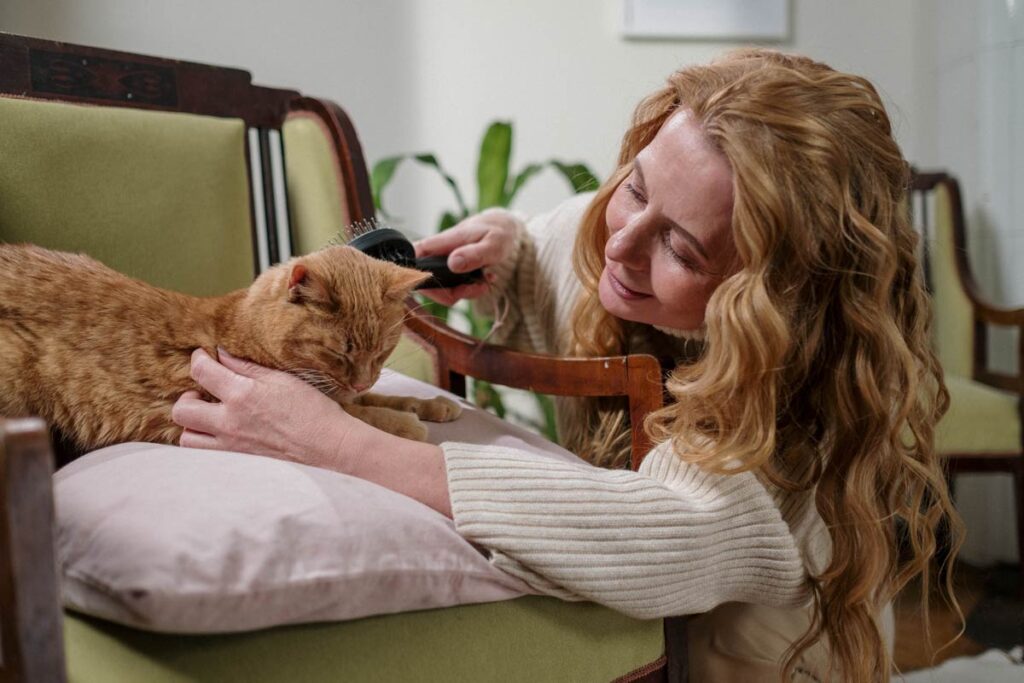If you’ve ever heard the saying ‘a house is not a home without a cat,’ then you already understand the profound impact these furry companions can have on our lives. And now, as you embark on your journey of adopting a cat, get ready to experience a whole new level of love and joy.
But before that happens, it’s important to know what to expect. In this article, we will guide you through the exciting world of cat ownership and provide you with valuable tips and advice along the way.
From preparing your home for your new feline friend to understanding their behavior, feeding and nutrition, veterinary care, grooming, bonding, playtime, and the responsibilities that come with being a cat owner – we cover it all.
So get ready to open your heart and home to a furry companion who will undoubtedly enrich your life in ways you never thought possible.
- Preparing Your Home for a New Cat
- Understanding Cat Behavior
- Feeding and Nutrition
- Veterinary Care and Health
- Grooming and Hygiene
- Bonding and Playtime
- Understanding the Responsibilities of Cat Ownership
- Frequently Asked Questions
- How long does it typically take for a new cat to adjust to its new home?
- What should I do if my new cat is not eating or drinking?
- Can I introduce my new cat to other pets in the household right away?
- How often should I schedule veterinary check-ups for my new cat?
- What are some common signs of stress or anxiety in cats, and how can I help alleviate them?
- Conclusion
Preparing Your Home for a New Cat
Get ready to transform your home into a feline-friendly haven as you prepare to bring a new cat into your life! Before bringing your new furry friend home, it’s important to make sure your house is safe and welcoming for them.
Start by creating a cat adoption checklist, which includes essential items like food and water bowls, litter boxes, scratching posts, and toys. Set up a cozy sleeping area with blankets or a cat bed.
Additionally, take the time to introduce your new cat to any existing pets gradually. This can help prevent conflicts and ensure a smooth transition for everyone involved. Understanding how cats behave is crucial in creating a harmonious environment for them.
Now that you’ve prepared your home, let’s dive into understanding cat behavior without further ado.
Understanding Cat Behavior
When it comes to understanding cat behavior, there are three key points you should focus on.
First, learning about body language and communication is crucial in deciphering what your cat is trying to convey. Recognizing common behaviors and their meanings will help you better understand your cat’s needs and emotions.
Lastly, addressing any behavioral issues that may arise is essential for a harmonious relationship with your feline companion. By delving into these areas, you’ll be equipped with the knowledge needed to effectively communicate with and care for your cat.
Learning About Body Language and Communication
Pay close attention to your new feline friend’s subtle signals and gestures – you’ll be amazed at how their mysterious body language can speak volumes without a single meow. Understanding cat body language is crucial for effective communication with your furry companion.
Here are some communication tips to help you decipher what your cat is trying to tell you:
- Tail: A straight-up tail indicates happiness, while a puffed-up tail signifies fear or aggression.
- Ears: Forward-facing ears show interest, while flattened ears suggest anger or fear.
- Purring: This soothing sound usually means contentment but can also indicate pain or distress.
- Eye contact: Direct eye contact is a sign of trust, while dilated pupils may signal excitement or fear.
By learning these cues, you will have a better understanding of your cat’s emotions and needs. Transitioning into the next section about recognizing common behaviors and their meanings, it’s important to delve deeper into decoding your cat’s behaviors.
Recognizing Common Behaviors and Their Meanings
Explore the fascinating world of your feline friend’s behaviors and their meanings to deepen your understanding of your furry companion.
Interpreting vocalizations is key to deciphering what your cat is trying to communicate. Whether it’s a soft purr indicating contentment or a loud meow signaling hunger or distress, paying attention to these sounds will help you respond appropriately.
Additionally, interpreting litter box behavior is crucial for maintaining your cat’s health and well-being. If your cat suddenly starts avoiding the litter box, it may be a sign of an underlying medical issue or stress. Understanding these behaviors allows you to address any potential problems early on and provide the necessary support for your cat.
Transitioning into addressing behavioral issues, there are various strategies you can employ to ensure harmony in your home with your new feline friend.
Addressing Behavioral Issues
To effectively address behavioral issues with your feline friend, it’s essential to understand their unique needs and provide a supportive environment. Here are three key tips to help you navigate common challenges:
- Addressing litter box issues: If your cat is having accidents outside the litter box, it could indicate a medical problem or stress. Ensure the litter box is clean and easily accessible. Consider using different types of litter or boxes to find what your cat prefers. Consult with a veterinarian if the issue persists.
- Introducing a new cat to existing pets: Take it slow and allow them to gradually get acquainted with each other’s scents before face-to-face interactions. Provide separate food bowls, water dishes, and litter boxes for each pet initially, then slowly integrate them into shared spaces under supervision.
By understanding and addressing these behavioral issues, you can create a harmonious home for both you and your new furry companion. Speaking of companionship, let’s now discuss feeding and nutrition for your cat…
Feeding and Nutrition
When it comes to feeding and nutrition for your cat, there are a few key points to keep in mind.
First, choosing the right cat food is crucial for their overall health and well-being. Make sure to look for a balanced diet that meets all of their nutritional needs.
Second, establishing a feeding schedule helps regulate their eating habits and prevents overeating. Stick to consistent meal times and portion sizes.
Lastly, monitoring your cat’s diet and weight is important to ensure they’re maintaining a healthy body condition. Keep an eye on their food intake and adjust accordingly if needed.
Choosing the Right Cat Food
Finding the right cat food can be a fun and rewarding experience for new cat owners. With so many cat food brands available, it’s important to choose one that meets your feline friend’s dietary restrictions. Look for brands that offer a balanced and complete diet, specifically formulated for cats.
Consider your cat’s age, weight, and any specific health concerns when selecting the appropriate food. Some cats may require special diets due to allergies or medical conditions, so consulting with a veterinarian is always recommended.
Once you’ve chosen the right cat food, you can move on to establishing a feeding schedule that suits both you and your new furry companion. It’s important to set regular meal times to ensure your cat maintains a healthy eating routine without overeating or becoming undernourished.
Establishing a Feeding Schedule
Establishing a feeding schedule for your feline friend is like orchestrating a harmonious symphony of nourishment and routine. Creating a feeding routine is essential to ensure that your cat receives the proper amount of nutrition on a consistent basis.
Start by selecting high-quality cat food that meets their dietary needs. When introducing new foods, do it gradually to avoid upsetting their digestive system.
Cats are creatures of habit, so try to feed them at the same time every day. This will help regulate their appetite and prevent overeating or underfeeding.
It’s also important to monitor your cat’s diet and weight closely, as any sudden changes could indicate health issues. By establishing a feeding schedule and monitoring their diet, you can provide your furry friend with the best care possible while maintaining their overall health and well-being.
Now let’s move on to monitoring your cat’s diet and weight without disruption in their daily routine.
Monitoring Your Cat’s Diet and Weight
Keeping an eye on what your kitty eats and how much they weigh is key to their overall health and happiness. Proper weight management is crucial for cats, as both obesity and being underweight can lead to various health issues.
Here are three important things to consider when monitoring your cat’s diet and weight:
- Portion control: Measure your cat’s food accurately to ensure they receive the right amount of calories each day. Follow the feeding guidelines provided by your veterinarian or cat food manufacturer.
- Regular weighing: Weigh your cat regularly using a pet scale or by visiting the vet. Sudden weight gain or loss could indicate underlying health problems that need attention.
- Balanced nutrition: Provide a balanced diet that meets all of your cat’s nutritional needs based on their age, size, and activity level. Consult with your veterinarian for specific dietary recommendations.
By closely monitoring your cat’s diet and weight, you can help them maintain a healthy body condition and prevent future health issues. Transitioning into the next section about veterinary care and health, it’s also essential to schedule regular check-ups with a veterinarian to ensure your new furry friend stays in top shape.
Veterinary Care and Health
When you bring your new furry friend home, make sure to prioritize their veterinary care and health, just like you would with a precious antique vase that needs regular maintenance and careful handling.
Regular veterinary check-ups are essential for keeping your cat healthy and catching any potential issues early on. Your veterinarian will perform a thorough examination, update vaccinations, and discuss preventive measures such as flea and tick control. Additionally, they can provide advice on nutrition, behavior, and dental care.
It’s important to be aware of common cat illnesses such as respiratory infections, urinary tract problems, or gastrointestinal issues. By staying proactive in your cat’s healthcare routine, you can ensure their well-being and prevent any unnecessary suffering.
As you transition into the next section about grooming and hygiene, remember that maintaining good overall health goes hand in hand with proper grooming practices.
Grooming and Hygiene

Maintaining a regular grooming routine will ensure that your furry friend’s coat stays shiny and free of tangles. Here are some essential tips for cat grooming and hygiene:
- Brushing: Regularly brushing your cat’s fur helps prevent matting, reduces shedding, and stimulates blood circulation.
- Bathing: While cats groom themselves, occasional baths may be necessary. Use cat-friendly shampoos and warm water to keep their coat clean.
- Nail Trimming: Keep your cat’s nails trimmed to prevent them from becoming too long or sharp. Be cautious not to cut into the quick.
- Oral Care: Promote good dental health by regularly brushing your cat’s teeth with special toothpaste made for felines.
Proper grooming not only keeps your cat looking great but also prevents various health issues. After all, a well-groomed kitty is a happy kitty!
Now let’s dive into the next section about bonding and playtime.
Bonding and Playtime
Bonding with your furry friend through playtime isn’t just enjoyable, but it also strengthens the unique bond between you and your cat, creating a world of endless fun and companionship. To enhance this connection, try different bonding techniques such as gentle petting, talking to your cat in a soothing voice, and offering treats during play sessions.
Interactive toys are also great tools for bonding. Toys that mimic prey-like movements or have hidden treats can engage your cat’s natural instincts and keep them entertained for hours. As you spend quality time playing together, observe your cat’s preferences and adjust accordingly to ensure they remain engaged.
Understanding the responsibilities of cat ownership is crucial in providing the best care for your new companion.
Now let’s delve into the next section: understanding the responsibilities of cat ownership…
Understanding the Responsibilities of Cat Ownership
To fully embrace the joys and challenges of owning a furry feline, it’s essential that you understand and embrace the responsibilities that come with being a cat owner.
One important responsibility is understanding litter box training. Cats are naturally clean animals and instinctively use a litter box. However, it may take time for them to get accustomed to their new surroundings and find the litter box. Be patient and consistent in showing them where it is located.
Additionally, managing allergies is another responsibility to consider. Some people may be allergic to cats, so it’s important to make sure everyone in your household can comfortably coexist with a cat before adopting one. Regular grooming and keeping your home clean can help minimize allergens.
Lastly, proper cat care includes providing food, water, shelter, regular veterinary check-ups, vaccinations, exercise, playtime, and lots of love and attention. By understanding these responsibilities and committing to them wholeheartedly, you’ll create a loving environment for your new feline friend.
Frequently Asked Questions
How long does it typically take for a new cat to adjust to its new home?
It typically takes a new cat about 2-3 weeks to adjust to its new home. To make the transition easier, create a safe and comfortable environment by providing hiding spots, and vertical spaces, and gradually introducing them to their new surroundings.
What should I do if my new cat is not eating or drinking?
If your new cat is not eating or drinking, try these tips to encourage them. Offer a variety of food options and ensure they have fresh water available at all times. If the issue persists, consult with a veterinarian for further guidance.
Can I introduce my new cat to other pets in the household right away?
To create a harmonious multi-pet household, follow these tips for introducing a new cat to existing pets: 1) Gradually introduce them by scent swapping and visual contact. 2) Supervise initial interactions and provide separate spaces.
How often should I schedule veterinary check-ups for my new cat?
Schedule veterinary check-ups for your new cat once a year. Regular visits are important to monitor their health, update vaccinations, and address any concerns. It’s crucial to establish a comprehensive medical history for optimal care.
What are some common signs of stress or anxiety in cats, and how can I help alleviate them?
To alleviate stress in cats, look for common signs like excessive grooming or hiding. Create a safe space with toys, scratching posts, and cozy beds. Introduce them slowly to existing pets to promote harmony in your household.
Conclusion
In conclusion, adopting a cat can be a rewarding experience for new owners. By preparing your home and understanding cat behavior, you can create a safe and comfortable environment for your furry friend.
Remember to provide proper nutrition and regular veterinary care to ensure their health and well-being. Grooming and bonding activities are essential for building a strong connection with your cat.
Lastly, it’s important to understand the responsibilities of cat ownership, as cats require love, attention, and care. Did you know that over 3 million cats are adopted each year in the United States? So go ahead, open your heart and home to a feline companion – they’ll bring joy and love into your life!
Read more:






























